Several studies state that lameness is the most prevalent health problem in horses and the main reason for retirement from their leisure use or competitive life (Clegg 2011; Ely et al. 2009; Dyson 2001). In this context, most pathologies appear in the structures of the equine distal limb at the forelimbs.
Injuries and disorders of joints, tendons and ligaments occur frequently. In particular, degenerative bone diseases such as desmitis, osteoarthritis, osteoarthrosis and podotrochlosis are common diagnoses in the equine practice. Thereby, the occurrence of orthopedic disorders related to the distal limb is independent of the athletic level and use of horses. Elite, as well as non-elite, riding horses are affected by wear of the sensitive structures at the distal limb (Murray et al. 2010). The question is: Why are the structures of the equine distal limb in the forelimbs so prone to acute or degenerative disorders?
Takeaways
- Large muscles with long fibers arranged parallel with the long axis of the muscle belly that insert with short tendons or aponeuroses to the bones in combination with strong, elastic fascia create the so-called “equine thoracic sling.”
- Due to the high load affecting the forelimbs, a strong and efficient elastic and shock-absorbing system is necessary to protect components of the passive locomotor system, such as tendons, ligaments, bones and joints from wear and tear.
- The musculotendinous units in the proximal locomotor system of the forelimbs are the main components for shock absorption and energy storage during the stance phase.
- Horses suffering from arthrosis, podotrochlosis, suspensory ligament lesions, tendon injuries or any other degenerative or acute disorder benefit from strong musculature.
The author hypothesizes that most “acute” injuries, such as tendon lesions and degenerative disorders, such as podotrochlosis, are the result of long-term wear, instead of an acute insult.
The global biomechanics of horses demonstrate that the forelimbs and hindlimbs have different static and dynamic functions. Due to their proximity to the horse’s center of mass, the front limbs carry more weight (57-58%) than the hindlimbs (42-43%) and experience proportionately higher vertical forces and impulses (Back, Clayton 2012).
In addition, the hindlimbs are the “engine” of the horse. Due to the reciprocal system of the hindlimb and muscle function, the hindlimbs enable the forward propulsion of the body (Biewener 1983). The forces created by the hindlimbs are transferred by back and trunk motion to the forelimbs, which must stabilize and carry the load of the horse’s body mass and support the forward movement of the animal (Harrison et al. 2012). Due to the high load affecting the forelimbs, a strong and efficient elastic and shock-absorbing system is necessary to protect components of the passive locomotor system, such as tendons, ligaments, bones and joints from wear and tear (Biewener 1998). This is provided by myofascial and tendinous units, which allow shock absorption and energy storage to reduce impact forces and the metabolic cost during locomotion.
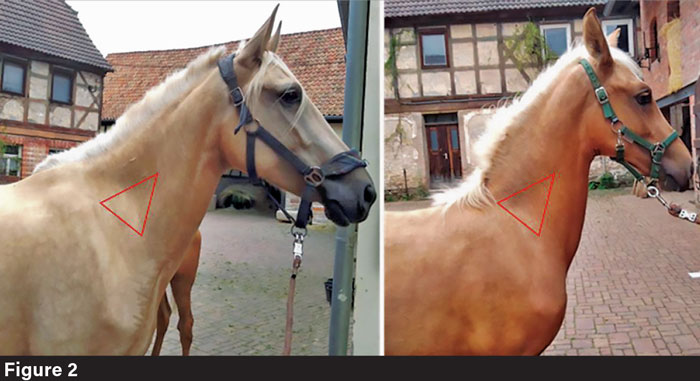
A mare and its foal with dysfunction in the musculotendinous system of the “thoracic sling” and missing support of the lower cervical vertebrae due to missing lamina of the nuchal ligament. Photo by: Dr. Jenny Hagen
Horses do not have a clavicle or any bony articulations between the scapula and the sternum or thorax. Instead, the articulation between the forelimb and the trunk is a sysarcosis, consisting of an elastic and strong group of extrinsic muscles and their associated soft tissue, such as tendons and facia (Dyce et al. 2010). Large, powerful muscles are concentrated at the proximal limb, while long and elastic tendons are located at the distal limb that contributes to an efficient, energy-saving locomotion.
The absence of a clavicle allows the scapula more range of motion and the possibility to rotate and translate relative to the thorax, which contributes to an increase in stride length (Back, Clayton 2012). In addition, the musculotendinous units in the proximal locomotor system of the forelimbs are the main components for shock absorption and energy storage during the stance phase (Harrison et al. 2012).
In conclusion, the musculotendinous system of the equine forelimb has the following functions (Back, Clayton 2012; Harrison et al. 2012; Biewner 1998).
- Connection of the forelimbs to the trunk.
- Supporting and stabilizing the body mass in stance and locomotion.
- Stabilizing the limb joints against the force of gravity during the stance phase.
- Energy storage and force creation for body propulsion and forward motion of the body.
- Shock absorption and protection of tendons, ligaments and joints from overload.
- Flexing the limb joints to enable lift-off of the hooves from the ground to the swing phase.
- Extending the forelimbs for increasing stride length in the final part of the swing phase.
- Therefore, the functionality of the system has a high meaning for the soundness and gait quality of a horse.
The extrinsic muscles of the forelimb, which have an attachment to the bones of the limb and an attachment to the trunk, are responsible for suspending the trunk between the forelimbs and for moving the forelimbs relative to the trunk (Back, Clayton 2012). Large muscles with long fibers arranged parallel with the long axis of the muscle belly that insert with short tendons or aponeuroses to the bones in combination with strong, elastic fascia create the so-called “equine thoracic sling.”
Learn More Online
Gain more insight into equine anatomy by reading:
- “Equine Reciprocating Systems: Examining the Shoulder to Thorax Junction,” in which Dr. Deb Bennett illustrates the relationship between the horse’s forelimb and the body.
- “Increased Knowledge of the Equine Anatomy Can Help Farriers Improve Hoof Care,” in which Cody Gregory of Heartland Horseshoeing School explains that the choices farriers make in trimming and shoeing should consider bones, tendons and other internal structures of the limbs.
- “Anatomical Knowledge is the Foundation to Understanding Biomechanics,” in which Dr. Jenny Hagen explains that optimal performance requires balanced interaction of all elements of the distal limb.
The dorsolateral components of this functional unit are the Rhomboideus cervicis et thoracis and the Trapezius muscle. Cranially, the scapula is connected to the trunk and the neck by the Brachiocephalicus, omotransversarius and subclavius muscles. The caudal connection between the shoulder and upper arm with the back and the hind limbs via the thoracolumbar facia is created by the latissimus muscle. The strong and medial attachment of the shoulder to the thorax is enabled by the serratus ventralis cervicis et thoracic muscle, which is ventrally supported by the Pectoralis muscles. (Figures 1a-1b) (Dyce et al. 2010).
During the evolution of the horse, these muscles were automatically strengthened and stretched if horses were walking free, between 6-11 km (4-7 miles) or even as much as 20 km (12 miles) per day to find food and water. The neck and shoulder system of horses are mainly designed for steady movement in slow walk or trot with a low head neck position. In particular, the free movement for multiple hours a day with several different motion patterns and a wide range of sensory stimuli was strengthening the musculotendinous units of the “thoracic sling.”
However, the modern (domestic) housing, keeping and use of horses do not necessarily contribute to the physiological needs of horses and often do not support the biomechanical functions of the locomotor system. In addition, there seems to be a genetic selection by breeding resulting in inherent musculotendinous dysfunctions (Figure 2).
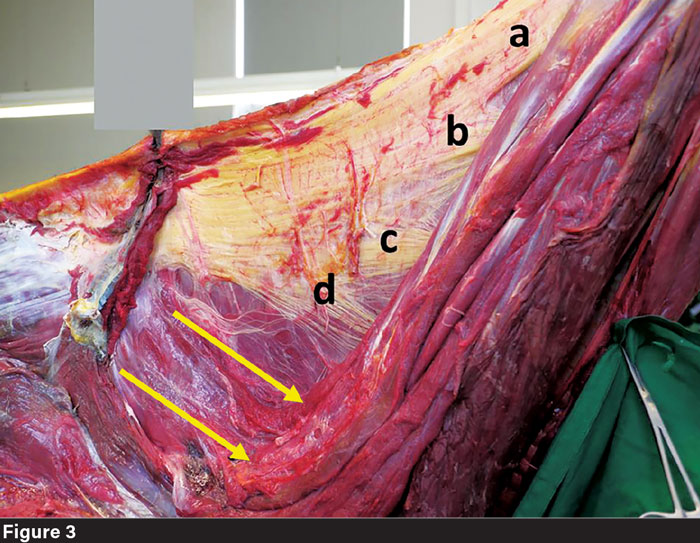
Several studies state that lameness is the most prevalent health problem in horses and the main reason for retirement from their leisure use or competitive life (Clegg 2011; Ely et al. 2009; Dyson 2001). In this context, most pathologies appear in the structures of the equine distal limb at the forelimbs. Photo by: Dr. Jenny Hagen
In some modern breeding types, there is a reduced strength of connective tissue. Horses are selected for high mobility and elasticity during locomotion, causing weakness of tendons and ligaments. During the dissection of 17 horses, it became obvious that in some modern warmblood horses, the lamina of the nuchal ligament connected to the fifth to seventh cervical vertebrae is incomplete or missing (Figure 3). This causes a lack of dorsal stability of the lower neck region. The resulting head-neck position makes it even harder for such horses to activate and use their “thoracic sling” to support their trunk against gravity.
However, the cause for a dysfunction of the “thoracic sling,” correlated with a lack of shock absorption and poor gait quality in the forelimbs, is not just caused by genetics and breeding. Housing, keeping and riding style might have a higher impact on this problem.
During these days a weakness (hypotrophy, hypotonia) of the Serratus ventralis, the Trapezius and the Omotransversarius muscles combined with a dysfunction (hypertrophy, hypertonia) of the Rhomboideus, Brachiocephalicus, Pectorales and Latissimus muscle occurs in increasing number.
In general, a lack of motion combined with a (tensed, chronic) high head-neck position contributes to dysfunction and weakness of the “thoracic sling.” Risk factors for the development of myofascial dysfunctions of the neck and shoulder associated with management, keeping and riding are described in the following.
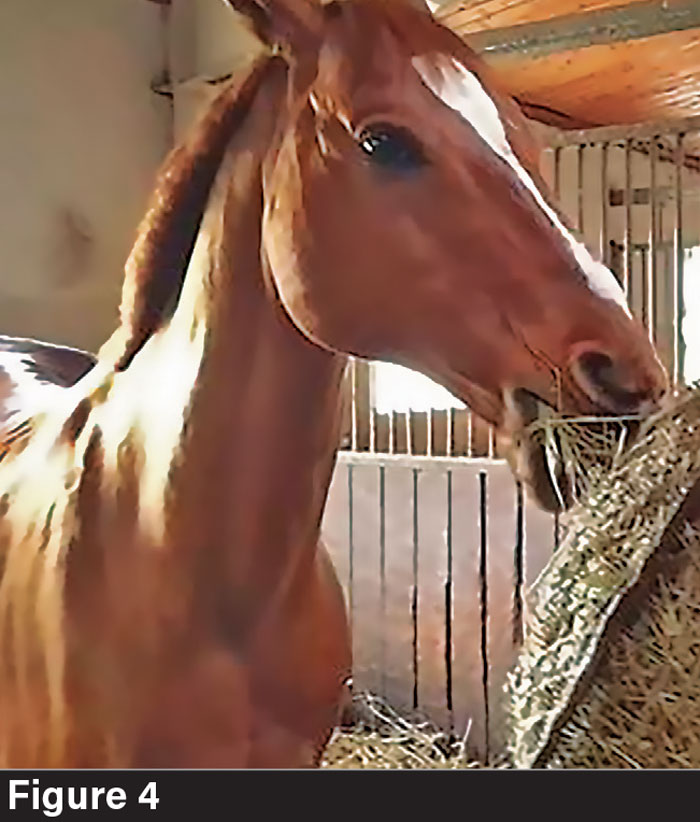
A horse with dysfunction of the “thoracic sling” due to feeding with the hay bag hanging too high. Photo by: Dr. Jenny Hagen
One crucial factor is box keeping with less possibility for free motion. This causes a weakening of important muscles to stabilize and carry the trunk and reduce the variety of motion pattern enabling the horse for self-carriage during standing, moving and riding. In addition, individual housing or frequent stress cause the need for permanent attention with lifted head to observe the environment. Missing rest, sleep and relaxation cause less time for lowering the head and neck and tensed muscles. The problem is reinforced by high feeding with hay bags hanging up (Figure 4). This causes an enforced high head-neck position with tension in the Rhomboideus and ventral neck muscles combined with “sinking” of the trunk between the scapulae and inactivity of the Serratus ventralis muscle. If these inappropriate housing and management conditions come along with a lack of sensory input and monotone training the problem increases.
The horse’s body is designed for a high variety of motion patterns and load. In nature, locomotion includes steady walk, jumping, running, sideways motions, turns, climbing uphill and downhill and moving on different soils. Today, most horses know the way from the box to the riding arena where they are always trained on the same ground surface and quite often with similar exercises. Even the pasture and paddocks are usually leveled with little possibilities for mental and physical stimulus.
This trend continues in the riding style. Fewer riders train and ride their horses in the countryside. Usually exercising in the riding arena or riding ground dominate the training. Athletic horses particularly are ridden in specific exercises to perfect the performance in the specific discipline. However, from human orthopedics, it is known that sports specialization and monotone training, particularly in children, cause overuse sport injuries with a long-life effect on the child’s soundness (OrthoInfo 2018). Children who specialize early are more likely to develop overuse injuries because of repetitive movements, be stressed and quit sports.
It is the same for horses. Monotone and repetitive exercises strengthen or even overuse specific muscle groups, which do not necessarily contribute to the physiological requirements of the horse’s body. The worst influence in this context is riding with a high head and neck position, hyperflexion of the poll and the neck, forcing the horse in a “frame” with draw reins or restricting equipment instead of enabling self-carriage and stabilization of the horse against the rider regarding the biomechanical demands of the horse.
Although the number of horses showing an insufficiency of the “thoracic sling” and myofascial dysfunctions is increasing, the problem remains undiscovered by riders, owners, trainers and veterinarians. Usually, horses become lame and diagnostics reveal an orthopedic disorder at the distal limb. From this moment, any kind of treatment focuses on the diseased structure (i.e. injections, pain medication, orthopedic shoeing).
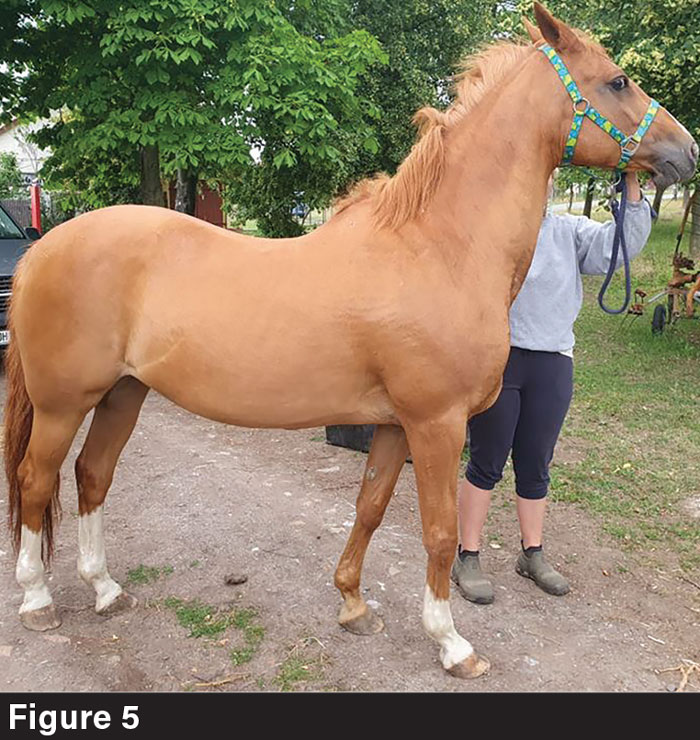
A horse with insufficient “thoracic sling” and myofascial dysfunction. Photo by: Dr. Jenny Hagen
Rarely is a functional evaluation of the horse’s body carried out to detect the origin and cause of the injury. A functional examination of the horse includes an evaluation of the whole body in the standing horse and during locomotion. A typical appearance of a horse with an insufficiency of the “thoracic sling” and myofascial dysfunctions includes the following (Figure 5).
- A concave topline.
- Concave troughs at the middle, lower neck region and behind the shoulder blade (“pseudoatrophy” of the Trapezius muscle).
- Little space between the dorsal edge of the shoulder blades and the spinal processes of the wither.
- Asymmetric shoulder height and angulation.
- Trunk sagging between shoulder blades.
- Prominent sternum between the forelimbs.
- Narrow appearing chest and “pseudo-belly.”
- Supporting the trunk with the elbows and the pectoral muscles.
- Valgus or toed-out limb conformation in the forelimbs.
- Tensed pectoral muscles.
- Hypertone and hypertrophy of the Rhomboideus muscle and ventral or lower neck muscles.
- Tension in the Latissimus dorsi muscle.
- Hypersensitive back.
- In these horses, the examination in walk and trot on straight line and in circles show.
- Lack of active dynamic stabilization (poor self-carriage).
- Poor gait quality with short strides, low flight arc in swing phase, tensed gait or stiff back.
- Frequent stumbling.
- Poor balance and suppleness.
- Reduced range of motion of the shoulder blades and the limb joints.
- Tension in the top line.
- Reluctant to move or running away.
- Heavy on the forelimb, loud gait, “stomping.”
- Restrictions in lateral bending.
- Uncoordinated movement pattern.
- Unspecific (intermittent), lameness.
- Additionally, behavior changes occur, such as the following.
- Hyper-reactivity, flight mode, high sympathicotonia.
- Aggression.
- Depression (Figure 6).
- Sudden explosive behavior.
- Hypersensitivity to touch, girth and saddle.
Furthermore, dysfunctions in the “thoracic sling” cause clinical symptoms such as frequent or ongoing disorders of the distal limb. Horses show intermittent lameness and degenerative diseases in the forelimbs, such as podotrochlosis, osteoarthrosis, or acute injuries with a high rate of recurrence. Due to gravity and muscular weakness, the structures and muscles of the “thoracic sling” are already under tension and stretched in the standing horse. There is hardly any more elastic elongation possible during loading in the stance phase. This causes a lack of shock absorption so that vertical ground reaction forces are directly transferred and absorbed by tendons, ligaments and joints of the forelimb. Moreover, the possibility of storing kinetic energy by elastic deformation of the musculotendinous system is limited, so limb propulsion to the swing phase is weaker and the gait quality decreases.
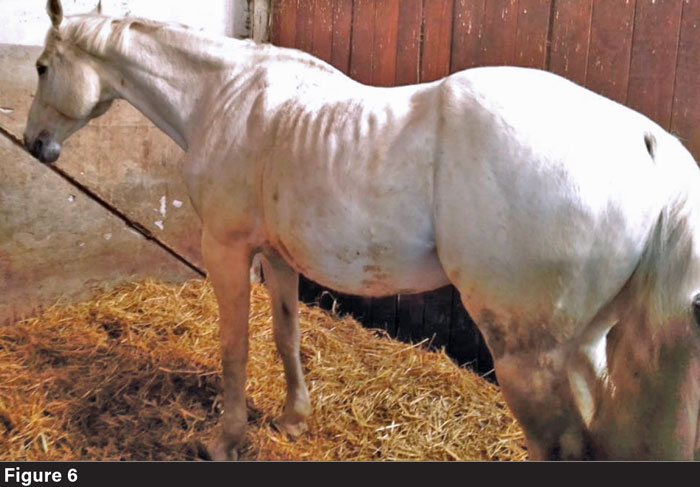
A horse with depression due to box keeping with less than 1-2 hours of access to the pasture. Photo by: Dr. Jenny Hagen
For increasing gait quality, preventing injuries and degenerative diseases of the distal limb or avoiding recurrence of disorders, the musculotendinous system of the “thoracic sling” must be strengthened. In particular, during rehabilitation, a specific training program to increase function of the shoulder muscles is crucial for a successful and sustainable rehabilitation of the orthopedic patient from disorders at the distal limb. In human medicine, patients with acute Achilles tendon injuries are encouraged to move during early rehabilitation to strengthen the muscles to achieve relief of the injured tendon.
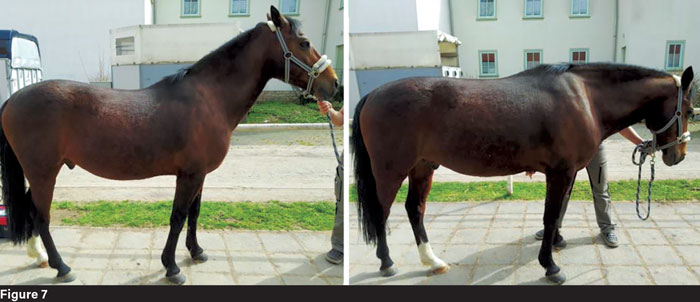
Elevation of the trunk activates and trains the “thoracic sling.” Photo by: Dr. Jenny Hagen
It is similar to horses. Horses suffering from arthrosis, podotrochlosis, suspensory ligament lesions, tendon injuries, or any other degenerative or acute disorder benefit from strong musculature. Muscles are the only parts of the locomotor system that enable the relief of passive structures, such as bones, joints, tendons and ligaments. It is impossible to achieve a successful and sustainable rehabilitation of the orthopedic patient with box rest and without a specific rehabilitation program. The aims of appropriate rehabilitation training are the following:
- Improving proprioception.
- Achieving facial release.
- Mobilization of the shoulder and the thorax.
- Strengthening the muscles of the shoulder sling, the back, the abdomen and the neck.
- Elevation of the trunk (Figure 7) (Stammer 2016).
- Increasing core stability and self-carriage in statics and dynamics (Stammer 2016).
- Improving lateral bending and symmetry.
Special training methods and concepts exist to reach this goal. Independent of the level of performance or the status of rehabilitation, different exercises can be added to the daily routine. It must be stated that all treating techniques that are used for myofascial release and joint mobilization might be useful to increase segmental mobility, but they usually destabilize the locomotor system so that hidden disorders or lameness might occur more obviously. It is essential to combine these techniques with specific training to enable the horse to stabilize its body physiologically and to improve its self-carriage. Muscles need to be activated and trained long-term, otherwise, the use of manual therapy is limited and not sustainable. They can be performed in stasis or motion from the ground or under the saddle. Useful training concepts are the following.
In the status of acute disorder until the end of rehabilitation:
- Myofascial release techniques.
- Osteopathy or chiropractic treatment to increase segmental range of motion and release compensatory posture and pain.
- During the early period of box rest:
- Use of balance pads.
- Exercises to improve core stability in stasis.
- Stammer kinetics in stance (Stammer 2016).
- During the progress of healing:
- Controlled walk on even ground.
- Stammer kinetics in walk (Stammer 2016).
- Tensegrity training (Veronika von Rohrscheid).
- In the final part of recovery:
- Hand-walk in the countryside provides a high variation of sensory, physical and mental stimulus.
- Pole work.
- Gaitner training.
- Stammer kinetics in walk and trot (Stammer 2016).
- Tensegrity training with increasing intensity (Veronika von Rohrscheid).
- At the introduction to training:
- Ridden exercises for improving core stability.
- Ridden tensegrity-training.
- Developing self-carriage under the rider.
- Riding in the countryside.
After the program, the horse can return to its specific use and athletic discipline. However, the aspects of the training program should be integrated into the athletic training to avoid the recurrence of the orthopedic disorder. However, it is crucial to adapt keeping conditions and riding style to physiological requirements and the biomechanical capacities of the horse to achieve a sustainable effect on the soundness and performance of the horse.

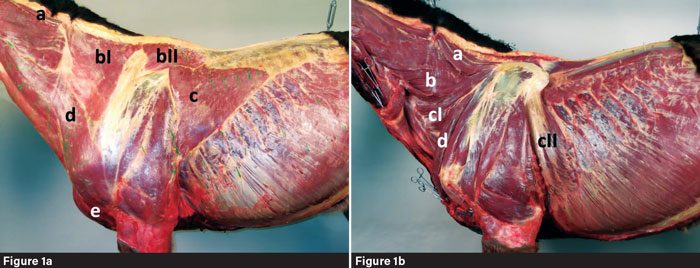
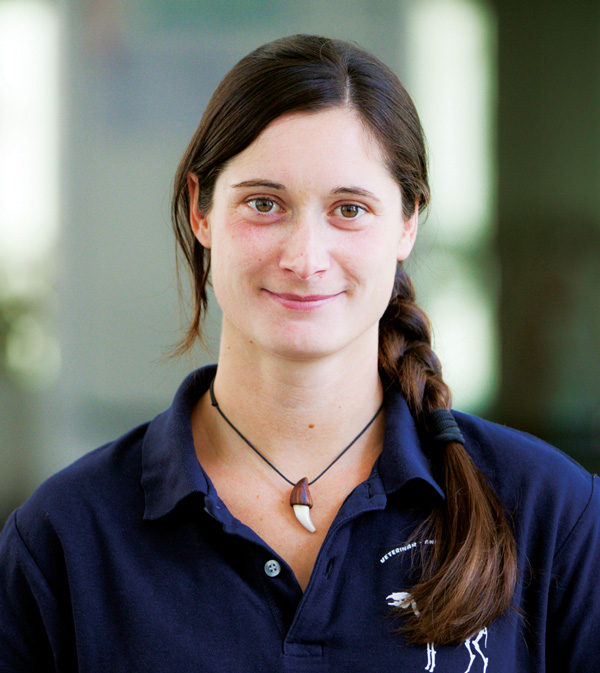






Post a comment
Report Abusive Comment